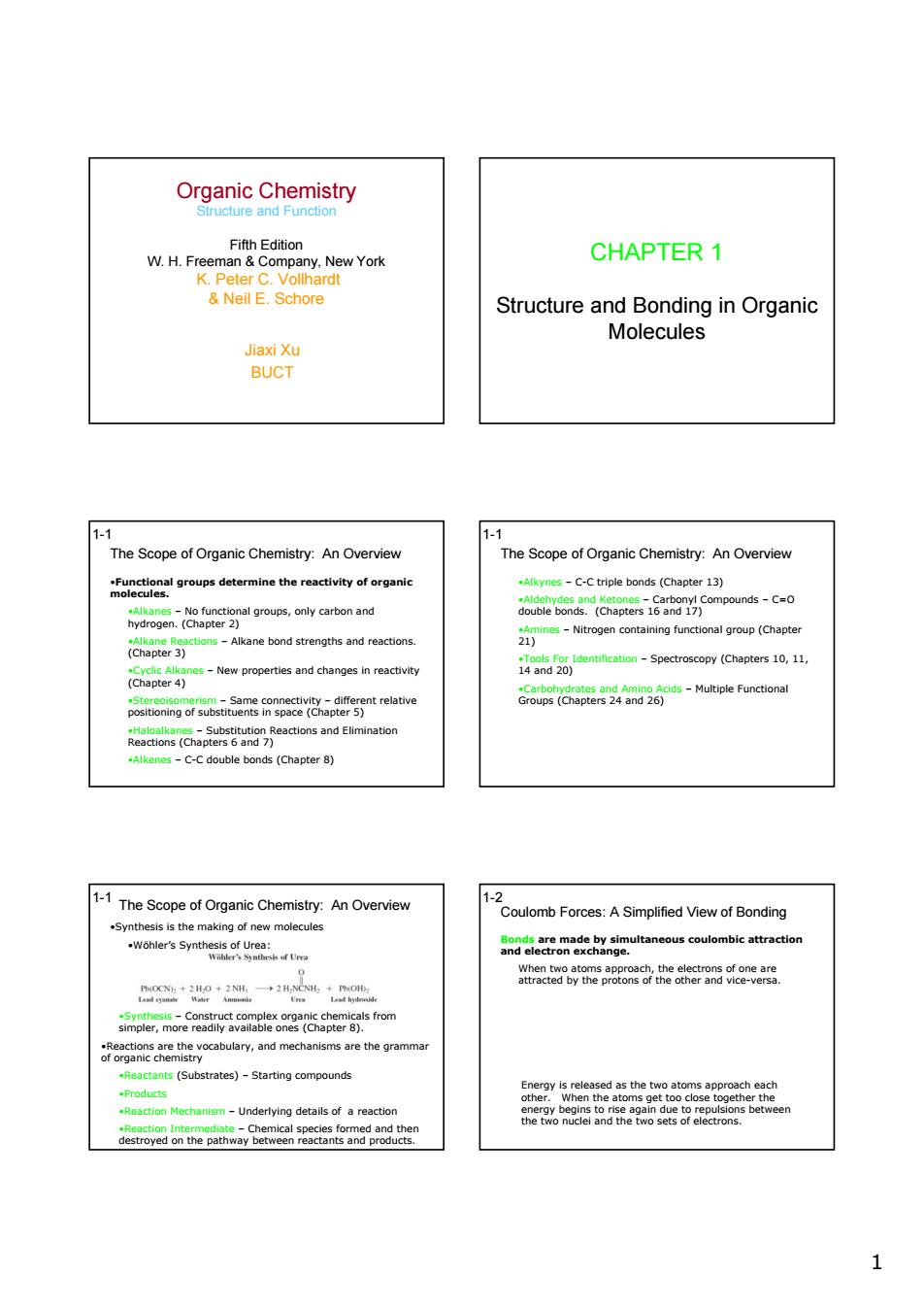正在加载图片...

Organic Chemistry ucture and Function CHAPTER 1 &Neil E.Schore Structure and Bonding in Organic Molecules Jiaxi Xu BUCT 1-1 The Scope of Organic Chemistry:An Overview The Scope of Organic Chemistry:An Overview Alkyres C-C triple bonds (Chapter 13) egen-ag9aloroups,omiycartonand bond strengths and reactons 2 Nitrogen cor u(Caperup Functional (Chapter 8) 1-1 The Scope of Organic Chemistry:An Overview 2couibnibForcesAsmpliedMewoiBondng aaaomakyge 0+20+2m一26+n 8taeaoane2a8oaeoteae9m3caeas (Substrates) 1 1 Organic Chemistry Structure and Function Fifth Edition W. H. Freeman & Company, New York K. Peter C. Vollhardt & Neil E. Schore Jiaxi Xu BUCT CHAPTER 1 Structure and Bonding in Organic Molecules The Scope of Organic Chemistry: An Overview 1-1 •Functional groups determine the reactivity of organic molecules. •Alkanes – No functional groups, only carbon and hydrogen. (Chapter 2) •Alkane Reactions – Alkane bond strengths and reactions. (Chapter 3) •Cyclic Alkanes – New properties and changes in reactivity (Chapter 4) •Stereoisomerism – Same connectivity – different relative positioning of substituents in space (Chapter 5) •Haloalkanes – Substitution Reactions and Elimination Reactions (Chapters 6 and 7) •Alkenes – C-C double bonds (Chapter 8) The Scope of Organic Chemistry: An Overview 1-1 •Alkynes – C-C triple bonds (Chapter 13) •Aldehydes and Ketones – Carbonyl Compounds – C=O double bonds. (Chapters 16 and 17) •Amines – Nitrogen containing functional group (Chapter 21) •Tools For Identification – Spectroscopy (Chapters 10, 11, 14 and 20) •Carbohydrates and Amino Acids – Multiple Functional Groups (Chapters 24 and 26) The Scope of Organic Chemistry: An Overview 1-1 •Synthesis is the making of new molecules •Wöhler’s Synthesis of Urea: •Synthesis – Construct complex organic chemicals from simpler, more readily available ones (Chapter 8). •Reactions are the vocabulary, and mechanisms are the grammar of organic chemistry •Reactants (Substrates) – Starting compounds •Products •Reaction Mechanism – Underlying details of a reaction •Reaction Intermediate – Chemical species formed and then destroyed on the pathway between reactants and products. Coulomb Forces: A Simplified View of Bonding 1-2 Bonds are made by simultaneous coulombic attraction and electron exchange. When two atoms approach, the electrons of one are attracted by the protons of the other and vice-versa. 2 (+) charge ( ) charge Attracting Force = constant distance × − × Energy is released as the two atoms approach each other. When the atoms get too close together the energy begins to rise again due to repulsions between the two nuclei and the two sets of electrons